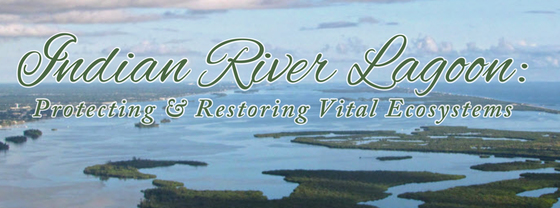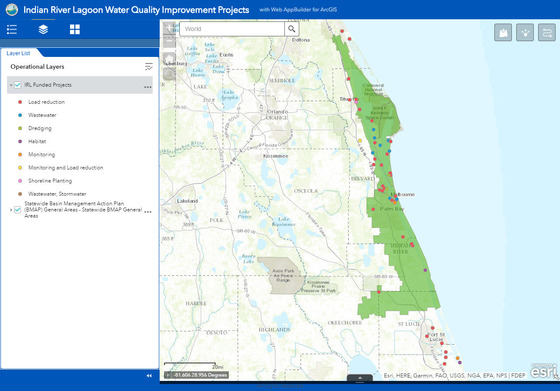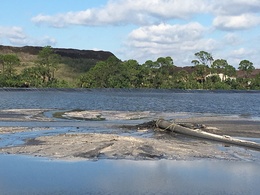 The Indian River Lagoon System is a 156-mile-long estuary
located on Florida’s east coast that spans from Daytona to Fort Pierce. This estuary, which directly and
indirectly supports a large part of the region’s and the state’s economy,
including tourism, recreation and fishing, has experienced seagrass die-off and
algal blooms due to excess nutrients from septic tanks, stormwater runoff and
muck sediment.
Recognizing
that the health of the Lagoon is vital to Florida’s environment, economy and
quality of life, the department has identified the Lagoon as a priority
waterbody for restoration. To formally implement the projects and activities
necessary to bring the Lagoon back to health, the department adopted
pollutant-reduction targets for nitrogen and phosphorus and established three
restoration plans to address specific challenges in each section of the Lagoon.
To benefit and protect the Indian River Lagoon, the Florida Department of
Environmental Protection has invested more than $142 million in nearly 70 projects to help
improve water quality in the past ten years. In addition to DEP funding, the St. Johns River and South Florida water management districts and local governments also provide funding for water-quality improvement projects.
This fiscal year, DEP has awarded more than $24 million in grants for 12 projects to help communities reduce stormwater nutrient loads, continue stormwater treatment improvements, reduce nonpoint source pollution and eliminate muck sediments.
Governor Rick Scott's "Fighting for Florida's Families" budget proposes funding for a 50/50 state matching grant program with local communities, including those along Indian River Lagoon, to provide funding to encourage residents to move from septic tanks to sewer systems in order to curb pollution that is currently entering impacted water bodies. Additionally, this proposal will support local communities to help build wastewater systems to meet the increased demand for wastewater services. Funding also includes $20 million for muck dredging and other capital improvement projects needed to improve water quality and reduce sources of pollution in these waterways.
 Click on the image above to access interactive map of nearly 50 current and upcoming water-quality projects benefiting Indian River Lagoon.
 The Florida Department of Environmental Protection awarded the St. Johns River Water Management District a total of $20 million from legislative appropriation grants for the Eau Gallie River muck dredging project. The project will remove approximately 632,000 cubic yards of muck sediment from the Eau Gallie River, a tributary of the Indian River Lagoon.
Muck build-up is
a result of nutrient pollution, sediment, grass clippings, leaves and
other organic matter entering the Indian River Lagoon over time and
accumulating at the bottom. As muck decomposes, it consumes oxygen needed
by fish and it releases nutrients that feed algae blooms.
Eliminating current
sources of muck and removing muck deposits are both crucial steps
toward improving water quality and the overall health of
the lagoon, including protecting fish and wildlife that call the
Indian River Lagoon home.
Pictured here, muck from the lagoon is being transported from a pipe into the dredged material management area.
Click here for more information.
|
Restoration of the Indian River Lagoon
To reduce excessive amounts of
nutrients in the Lagoon, the department adopted three basin management action
plans, or BMAPs, in 2013 that address nutrient reductions in specific areas of
the Lagoon.
These nutrient reductions will aid in
the recovery of deeper water seagrass habitats which
scientists use as the primary indicator of the Lagoon’s overall health.
Seagrasses are
essential to the Lagoon, serving as a nursery for juvenile fish, a habitat for
shrimp and other animals, and a staple food for endangered manatees.
St. Johns River
Water Management District scientists along with DEP’s aquatic preserves and other
partners regularly monitor seagrass growth throughout the Lagoon, to evaluate
recovery and to improve the understanding of these life-sustaining submerged
plants.
North Indian River
Lagoon
The North IRL – which extends from Turnbull Creek to the
Melbourne Causeway – was further divided into two project zones. To date,
projects and activities undertaken by local governments and others in the North
A project zone have achieved approximately 30 percent of the total nitrogen reductions
and 53 percent of the total phosphorus reductions needed to meet restoration
targets.
In the North B project zone, these projects resulted in an
estimated 48 percent of total nitrogen and 59 percent of total phosphorus
reductions needed to meet restoration targets.
Local stakeholders have undertaken street-sweeping projects,
educational efforts and identification of priority muck-removal locations.
Central Indian
River Lagoon
The main stem of the Central IRL subbasin extends from the
Melbourne Causeway in Brevard County to the boundary between Indian River and
St. Lucie counties. DEP further divided the Central IRL into three project
zones.
Projects for which load reductions could be quantified
resulted in an estimated reduction of 14,953 pounds/per year of total nitrogen
loadings and 3,998 pounds/per year of total phosphorus loadings.
Local stakeholders in all three project zones have
undertaken an array of pollutant-reducing initiatives, including stormwater
projects, drainage improvements, septic tank conversions and adoption of
fertilizer ordinances.
Banana River
Lagoon
The Banana River Lagoon is located between the barrier
island communities of Cape Canaveral, Indian Harbour Beach and Merritt Island,
and at its southern end connects to the IRL. The BRL is further divided into
two project areas.
Best management practices and projects implemented in both
zones have reduced 25 percent of total nitrogen loadings and 26 percent of
total phosphorus loadings necessary to meet restoration targets.
Fertilizer ordinances, street sweeping, stormwater projects
and beach/city cleanup events have helped reduce nutrient loadings.
The eight state parks and three aquatic preserves along the Indian River Lagoon offer access to a multitude of nature-based and recreational activities including boating, hiking, swimming and wildlife watching.
|